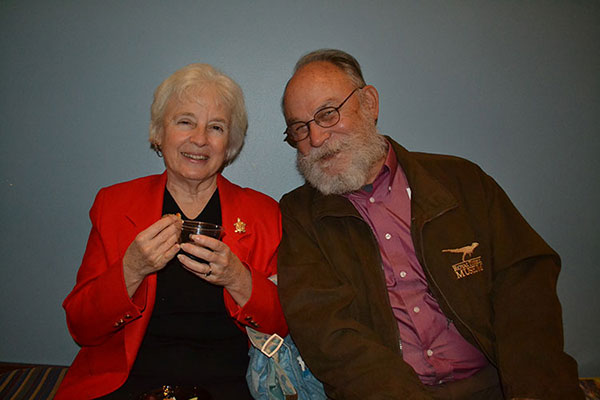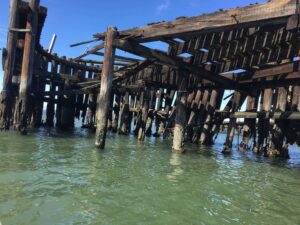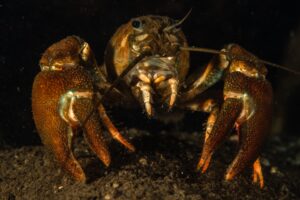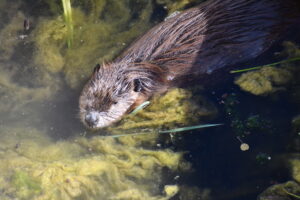The son of Russian immigrants living in post-war Shanghai, Igor Skaredoff moved to California with his parents at the age of six, and has been here for most of his life. After a long career as an environmental engineer for Shell Oil, Skaredoff retired from industry and dedicated himself to advocating for the creeks and watersheds of Contra Costa County as a volunteer with the Friends of Alhambra Creek in Martinez and as chair of the Contra Costa Resource Conservation District. He also volunteers with the John Muir Association and stays involved in the civic affairs of his home town of Martinez.
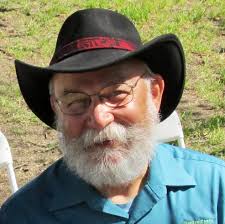
In 1948, on a troop ship from Shanghai. My family had been Russian refugees on the losing side of the Russian civil war (my grandfather had been a high-ranking metallurgical engineer). Both branches of the family had to leave Russia, and they ended up in Shanghai. The city had quite an expatriate community, with many English, French, and German refugees. My father worked as a longshoreman, and my mother worked as a secretary.
I guess I can trace my love for nature back to that time. Shanghai was a pretty grim place during the war. I grew up in a crowded tenement, and there were many beggars wandering the streets. But in the front yard of our building there was an acacia tree. We’d pick up the blooms dropped from the tree and sit around the fire and talk about the Russian prairies and other natural treasures of the country. It became an ideal in my mind. After the war, my mother’s uncle sponsored us to come to America.
How did it feel to enter the San Francisco Bay that first time?
We crossed under the Golden Gate Bridge in the middle of the night, when it was foggy, so we didn’t get to catch a glimpse of it. But in the morning we passed beneath the Bay Bridge and I looked up and saw the Key System trains that used to run on the lower deck of the bridge. It was like a beautiful dream. Then my uncle picked us up in a big black car and drove us through Golden Gate Park. It was marvelous.
Where did you go to school?
 My brother and I went to the local schools. In 1959 I graduated from Washington Union High School in Centerville, one of the towns that got combined into Fremont in the ’50s. Then I went to San Jose State and got a BS in chemistry. I met my wife Shirley there – we were lab partners.
My brother and I went to the local schools. In 1959 I graduated from Washington Union High School in Centerville, one of the towns that got combined into Fremont in the ’50s. Then I went to San Jose State and got a BS in chemistry. I met my wife Shirley there – we were lab partners.
Where did you go to work after getting your degree?
I worked for Shell Oil starting in 1964, and worked there for the next 35 years, mainly in environmental chemistry. During my time there the company changed for the better, and I like to think I played a small role in that.
What did you do there?
My job involved various environmental issues, including the water treatment facilities. I was involved in implementing water purification and testing procedures and training people in them. Whenever there was a problem, I was active in trying to trace it back to its source. The effluent from the refinery used to flow directly into the Bay; you could see the sheen on the water. But now the water has to be pure enough that rainbow trout can live in it.
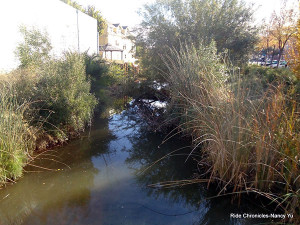
What was your first glimpse of Alhambra Creek?
When Shirley and I were first married we lived in a little apartment overlooking the ferry building at the Martinez marina for $110 a month. That was my first view of the creek. There was no park there; it was just a dumping ground. But I used to go down there sometimes and fish.
Later we rented a small house on E Street. It was bounded on two sides by the creek. In the summertime, the frogs would start singing. They’d get so loud we could hardly hear each other talk when the windows were open. Then they’d suddenly fall quiet. Little by little it would build back up and the chorus would start over again.
How did you get involved with the Friends of Alhambra Creek?
In the late 1980s Shirley saw a little article in the paper: the Friends were going to be showing slides about a hike they’d led going up the length of the creek. We started to volunteer; we did cleanups and manned booths at events.
The group’s founder, Kathy Radke, had been a Martinez city council member.When she decided to run for county supervisor, she asked one of us to take over as chair of the organization. No one wanted to do that; we thought Kathy could walk on water! But Shirley said she’d do it for a year or two. That was around 1993. She’s still the chair and I’m the go-fer.
What do you consider the Friends’ greatest accomplishments?
Two stand out most: opening up Alhambra Creek in downtown Martinez and making it the centerpiece of the town; and developing a user’s manual for the entire watershed.
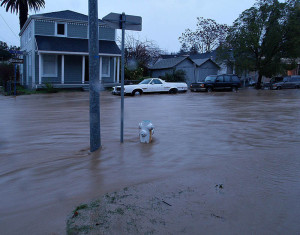
Martinez used to flood all the time because the creek had been diverted and covered over so the channel wasn’t big enough. Businesses would be damaged and streets would be covered with mud. This would happen 3-4 times a year. It’s hard to revitalize a downtown when it floods every year. So we partnered with the city, the Water Quality Control Board, and the Department of Water Resources to open up the creek in downtown Martinez.
We started with a short-term demonstration project to show how daylighting the creek could work: We cobbled together 3-400,000 dollars and opened up the creek in the most popular parking lot in town. It brought the creek out so people could know it was there. But it continued to flood: There was a horrendous flood in 1997. So then the city took the lead and partnered with the flood control district and various engineers and found more mitigation money to incorporate greater flood control measures into the design. And the city had an election and the residents voted to tax themselves based on the risk of flooding on their properties.
This larger project extended from Green Street out to the mouth of the creek where it meets the Sacramento River. We also got funding to build a creek plaza and make it a community-focused place. It wouldn’t have happened that way if we hadn’t done the pilot project.
Our other big accomplishment was the watershed user’s manual, which has been our blueprint for managing the watershed ever since we published it in 2003. It’s a guide on how to live in a watershed – how to deal with issues like flooding, fire, and habitat. We had 30 stakeholders, including property owners, educators, ranchers, city people, and people from the flood control district (which was the main impetus behind the plan).
The Contra Costa County Resource Conservation District (RCD) was the parent agency that helped us to produce the Watershed Plan, and it was through this experience that I got involved with them. Because we approached this in a collaborative way, all done by consensus, it was successful. This process can be painful – one stakeholder can torpedo it – but because we had ploughed through it together we had no opposition at the end.
What are some of your latest projects?
We’re trying to improve the passage for salmonids where Pinole Creek passes under I-80; the fish can’t get past the highway. We’re putting in a channel and some step pools so they can get in there. If all goes well it will go in this year.
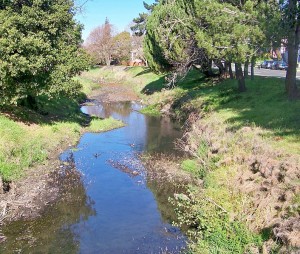
Are there already fish in Pinole Creek, or are you trying to coax them there?
There is a sporadic run of salmonids up the creek. Most of the reports we get are anecdotal, but they’re probably steelhead. Pinole Creek does have a much more reliable source of water and more protected lands and they’ve documented lots of steelhead. This creek has a bit more water than Alhambra Creek – the watershed land belongs to EBMUD and they care for it.
What about Alhambra Creek? Are any fish currently living in it?
Alhambra Creek is not prime salmon habitat – it’s got too much sediment. But up higher where there’s more gravel and rocks, in a good wet year we could have salmon spawn. We’ve done two fish surveys 15 years apart, and found native stickleback and pikeminnows. And we did a project next to the adult school: In some isolated pools we found eight small rainbow trout, so they’re definitely there. Even if we don’t have a robust salmon run, we do have this population of native fish. And we have the beavers!
.jpg)
Do you think the legacy of John Muir’s longtime residency in Martinez is a source of inspiration for the town’s very active environmental community?
People do take ownership here. The national park [the John Muir National Historic Site] came about through community action. We seem to have a disproportionate number of people who want to be active in the community. We have a fair number of writers and musicians – this adds to the richness. One of the favorite participatory sports here is to go to a city council meeting.
In addition to all of your creek activities, you’re also involved in local civic groups. Where else do you volunteer your time?
I also volunteer at the Boys and Girls Club in town. We did a little science experiment today. We made a battery made out of pieces of fruit that turned on a light! I love doing chemistry and making it interesting and relevant.
What inspires you personally?
I’m inspired by the word consensus.
And back in 1995 I had bypass surgery. You’re living off a machine. I consider the years since then extra years. Whenever I get frustrated or angry I think, well, you’re not even supposed to be here.
What’s your favorite place to hike and enjoy nature in the Bay Area, and why?
One place I go a lot is Hidden Lakes park in the hills south of Highway. 4. Three little lakes built 100 years ago by a rancher. It’s a city park, with double-crested cormorants, mergansers, river otters, and all kinds of birds in season passing through. We can walk there from our house. The other touchstone is Briones Regional Park. When I was transferred to Louisiana for ten years, that’s where we went to say goodbye – and that’s where we came when we returned. In the spring, it looks like the wildflowers are arranged at eye level for you, and we enjoy seeing bluebirds and coyotes.
>> Get Involved: Learn more about the Friends of Alhambra Creek and their hikes and restoration activities by visiting their web page (hosted at CCRCD.org) at: http://www.ccrcd.org/alhambra.html
>> Have Fun! Igor will be MC’ing the John Muir Earth Day/Birthday Celebration on Sat, April 26th at the John Muir Historic Site. Join Bay Nature and other local groups for a fun-filled day of celebration. Learn more

